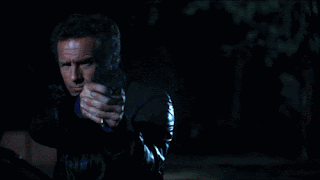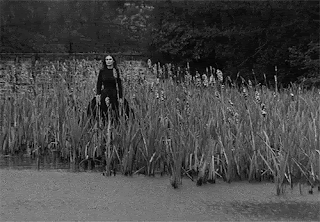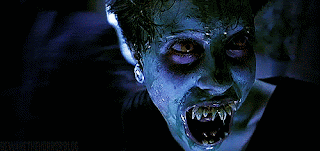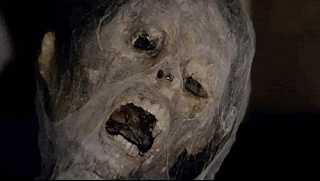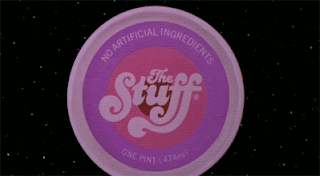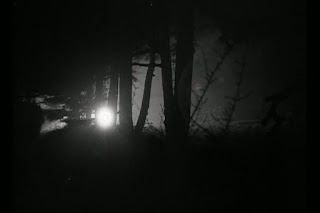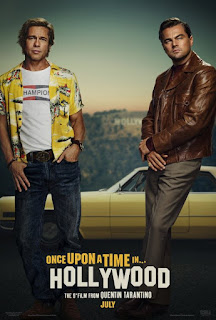 Once Upon a Time...in Hollywood, the ninth film from Quentin Tarantino, is a movie lover's dream. A sprawling character piece set against the backdrop of 1969 Hollywood, the film focuses on Rick Dalton (Leonardo DiCaprio), a tv cowboy who failed to make the jump to movies, and Cliff Booth (Brad Pitt), his stunt double, gofer, handyman and best friend. Living next door to Rick, are Roman Polanski (Rafal Zawierucha) and Sharon Tate (Margot Robbie), the uncrowned king and queen of the New Hollywood that threatens to render him obsolete. The characters traverse the changing cultural landscape and film industry over the course of 2 and a half days, with the ticking clock of the inevitable tragedy perpetrated by the Manson family driving the narrative from behind the scenes. Though the film is largely plotless, instead allowing its characters to steer us through a variety of ironic, hilarious and poignant scenes that only Tarantino could write, with an ending befitting its title and showing another side to the filmmaker.
Once Upon a Time...in Hollywood, the ninth film from Quentin Tarantino, is a movie lover's dream. A sprawling character piece set against the backdrop of 1969 Hollywood, the film focuses on Rick Dalton (Leonardo DiCaprio), a tv cowboy who failed to make the jump to movies, and Cliff Booth (Brad Pitt), his stunt double, gofer, handyman and best friend. Living next door to Rick, are Roman Polanski (Rafal Zawierucha) and Sharon Tate (Margot Robbie), the uncrowned king and queen of the New Hollywood that threatens to render him obsolete. The characters traverse the changing cultural landscape and film industry over the course of 2 and a half days, with the ticking clock of the inevitable tragedy perpetrated by the Manson family driving the narrative from behind the scenes. Though the film is largely plotless, instead allowing its characters to steer us through a variety of ironic, hilarious and poignant scenes that only Tarantino could write, with an ending befitting its title and showing another side to the filmmaker.I will say no more in regard to the synopsis, as the less you know going in, the better. No spoilers here.
Pitt and DiCaprio are in top form, oozing movie star charisma, while also displaying their comedic chops like never before. Robbie is a ray of sunshine, glowing in every scene. The remaining ensemble is filled out by an astounding collection of actors, Al Pacino, Damian Lewis, Timothy Olyphant, Bruce Dern, Luke Perry, Kurt Russell, Dakota Fanning, Mike Moh, with two stand out performances from relative newcomers: Margaret Qualley as a hippie chick and Julia Butters as a young, studious actor.
 The production design by Barbara Ling is impeccable, and sadly it is likely the last we will ever see on such a grand scale, that isn't heavily reliant on CGI. The soundtrack is filled with lesser known songs from the era, plus vintage radio ads, weather reports and DJ riffs. The cinematography by Robert Richardson is subtle with flourishes of majesty, utilizing various film formats (8mm, 16mm, 35mm) and aspect ratios to create a collage of home movies, tv shows and films within the film.
The production design by Barbara Ling is impeccable, and sadly it is likely the last we will ever see on such a grand scale, that isn't heavily reliant on CGI. The soundtrack is filled with lesser known songs from the era, plus vintage radio ads, weather reports and DJ riffs. The cinematography by Robert Richardson is subtle with flourishes of majesty, utilizing various film formats (8mm, 16mm, 35mm) and aspect ratios to create a collage of home movies, tv shows and films within the film.All this serves to create an epic elegy to a bygone era of film and television, a tribute to B actors and stuntmen and all the unsung heroes of cinema past, and a yearning for the glitz and glamour of show business, real or imagined, it doesn't matter. It's also a deeply felt ode to friendship, and it's Tarantino at his most heartfelt. Only he could deliver an original film in today's market and have it received with fanfare otherwise only allotted to superhero blockbusters. I waited in line and saw the film in a packed house on a giant screen, projected in 70mm, it was an event. The way movies used to be seen, in the era of Rick and Cliff. The irony is not lost on Tarantino. The "movie" experience is on its way out, so I recommend you see it on a big screen with a big crowd, while you still can.
It's how movies were made to be seen.









